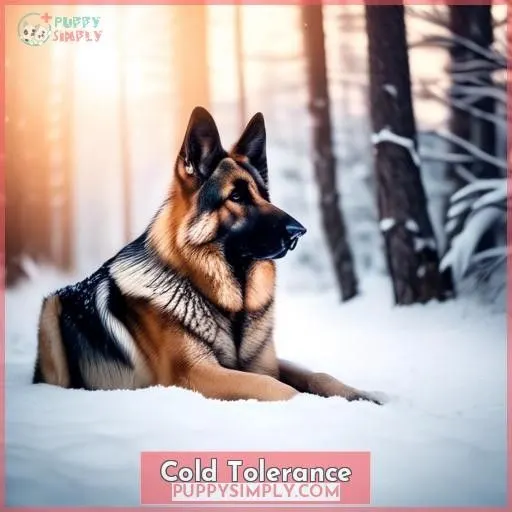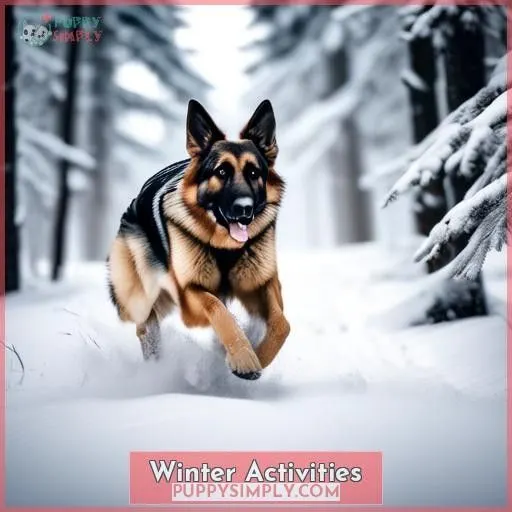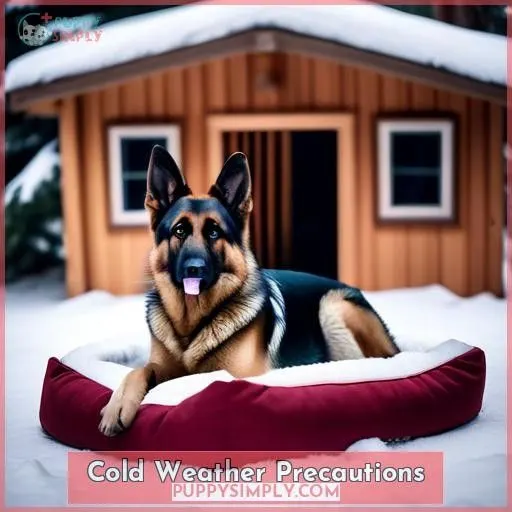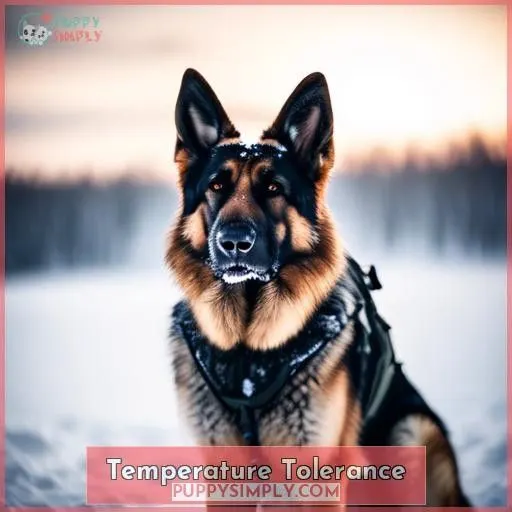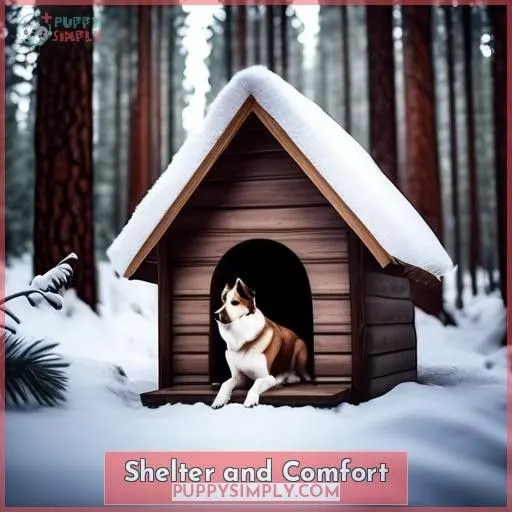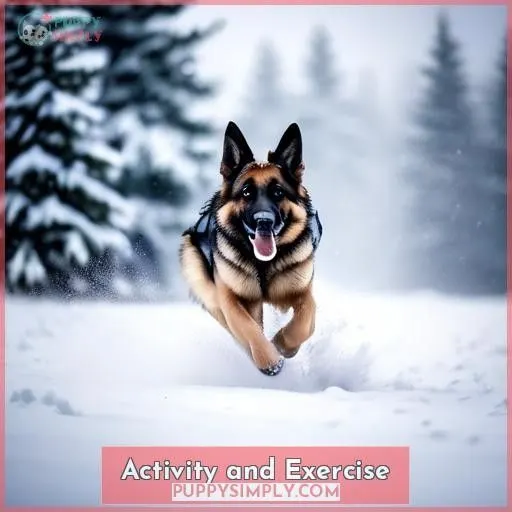This site is supported by our readers. We may earn a commission, at no cost to you, if you purchase through links.
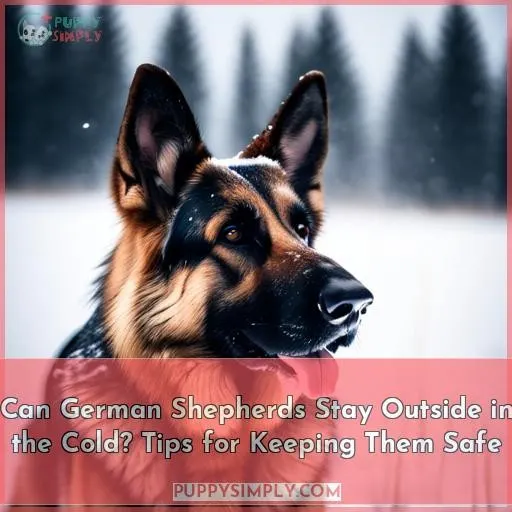
Yes, German Shepherds can stay outside in the cold, but it’s essential to give them proper care and protection. Their thick double coat helps insulate them, but extreme temperatures can still be uncomfortable. Puppies, senior dogs, sick dogs, and dogs without an undercoat are more likely to have cold-related health issues.
Watch your dog’s behavior for signs of discomfort, and make sure they have access to fresh water. Winter activities can be enjoyable, but supervise in extreme cold. Provide warmth and protection, and adjust activities based on the thermometer.
Table Of Contents
Key Takeaways
- German Shepherds can stay outside in the cold, but they need proper care and protection.
- Their thick double coat helps insulate them, but extreme temperatures can still be uncomfortable.
- Puppies, senior dogs, sick dogs, and dogs without an undercoat are more likely to have cold-related health issues.
- Watch your dog’s behavior for signs of discomfort, and make sure they have access to fresh water.
Can German Shepherds Stay Outside in the Cold?
Yes, German Shepherds can stay outside in the cold, but there are precautions to take. They can tolerate temperatures as low as 20 degrees Fahrenheit and even handle temperatures as low as –10 to -15 degrees Fahrenheit for short periods as long as they stay dry.
However, puppies, senior dogs, sick dogs, dogs without an undercoat, and dogs that are malnourished shouldn’t be exposed to extreme cold. It’s essential to provide them with a warm shelter, bedding, and proper nutrition.
German Shepherds can spend only a limited time outside in cold weather, and the time allowed will depend on several factors, including the temperature and wind chill, the dog’s overall health, and its age.
Cold Tolerance
German Shepherds are known for their ability to handle cold weather, but they aren’t immune to the effects of extreme temperatures. Understanding their cold tolerance and how to keep them protected is vital for their well-being.
German Shepherds have a double coat that acts as insulation, helping them stay warm in chilly temperatures. However, they can still get cold in extreme weather and may develop hypothermia. Signs of hypothermia include shivering, lethargy, and weakness. To prevent hypothermia, it’s imperative to provide your German Shepherd with a warm coat or blanket, limit their time outdoors in very cold weather, and monitor their behavior for signs of discomfort.
In winter, German Shepherds can enjoy activities like playing fetch in the snow, building a snowman, and sled pulling. However, it’s important to supervise these activities and avoid leaving your dog outside for extended periods in freezing temperatures.
German Shepherds can tolerate temperatures in the 40s (4-9°C) and may even prefer colder temperatures. However, individual factors such as age, health, and coat thickness can affect their cold tolerance. Senior dogs, dogs with short hair, or dogs with arthritis may be more sensitive to cold weather.
To make sure your German Shepherd stays safe in cold weather, provide them with a raised dog house with a blanket and pillow, elevate the dog house to prevent drafts, and make sure they’ve access to fresh water. Monitor their behavior for signs of cold stress, such as shivering, lethargy, and decreased appetite, and adjust their routine accordingly.
Winter Activities
Don’t let the cold weather stop your German Shepherd from having fun! Engage in winter activities that are safe and enjoyable for both of you. Here are some ideas:
- Snow games: Play fetch in the snow, hide and seek, or build a snowman together.
- Exercise frequency: Maintain your German Shepherd’s activity level, but adjust based on the temperature.
- Temperature monitoring: Keep an eye on the thermometer and adjust activities accordingly.
- Paw protection: Keep your dog’s paws dry and clean to prevent discomfort and frostbite.
Cold Weather Precautions
After playing in the snow, it’s essential to make certain your German Shepherd doesn’t become an icicle.
Cold tolerance isn’t just about enduring the chill; it’s about sensible precautions.
Wrap them in a warm blanket or think about a heated bed for that extra cozy factor.
Keep their shelter comfortable to ward off frostbite, and always watch for signs of lethargy.
Let’s not confine our furry friends to the cold; they deserve warmth and protection, not just during winter activities but all season long.
Breed Characteristics
German Shepherds are a versatile breed known for their intelligence, loyalty, and adaptability. They’re well-suited for various climates, including cold weather. Here are some key points about their breed characteristics in relation to cold tolerance:
- Fur Thickness: German Shepherds have a thick double coat that acts as insulation, helping them stay warm in chilly temperatures. The outer layer is coarse, while the undercoat is thick and insulating.
- Body Size: Their size is perfect for living in cold climates, as it helps them retain heat.
- Energy Levels: Their high activity level helps them stay healthy and fit, even in cold weather.
- Heat Tolerance: While they can tolerate moderate heat, they’re prone to overheating and need protection in hot weather.
- Cool Environment: German Shepherds thrive in cooler environments and can tolerate temperatures as low as 20-30°F (-6°C to 5°C).
- Warm Location: They can still get cold in extreme weather and may develop hypothermia, so they need extra protection in cold weather.
- Sun Protection: In hot weather, they need protection from the sun, such as shade and pet-safe sunscreen.
Misconceptions
Misconceptions about German Shepherds and Cold Weather
German Shepherds, known for their thick double coats, are often mistakenly believed to be naturally cold-resistant. However, this is a misconception. While their coats provide insulation, they can still get cold in extreme weather conditions. Here are some common misconceptions about German Shepherds and cold weather:
- Myth: German Shepherds don’t need extra warmth in cold weather.
Fact: German Shepherds can benefit from additional warmth in cold weather to stay comfortable.
- Myth: German Shepherds can stay outside in freezing temperatures.
Fact: Leaving German Shepherds outside in freezing temperatures can lead to hypothermia and frostbite.
- Myth: German Shepherds with thick fur alone are sufficient.
Fact: Their fur can become wet, reducing insulation, and they may still feel chilly, especially in harsh winter conditions.
- Myth: German Shepherds don’t need exercise in winter.
Fact: German Shepherds are an active breed that requires regular exercise, even in winter.
- Myth: German Shepherds can handle extreme cold without any precautions.
Fact: While German Shepherds can tolerate cold weather, they still need protection from extreme cold and wet conditions.
- Myth: German Shepherds can handle cold weather without any preparation.
Fact: Preparation, such as providing adequate shelter and warmth, is essential for German Shepherds in cold weather.
- Myth: German Shepherds are immune to cold-related health issues.
Fact: German Shepherds can suffer from hypothermia, frostbite, and other cold-related health issues if not properly cared for.
- Myth: German Shepherds aren’t affected by cultural implications, housing considerations, geographic limitations, or veterinary advice.
Fact: These factors can notably impact a German Shepherd’s ability to cope with cold weather.
Temperature Tolerance
German Shepherds are renowned for their resilience in cold weather, but it’s crucial to discern their temperature limits to guarantee their well-being and safety. Here are some key factors to take into account:
-
Coat Thickness: A German Shepherd’s dense double coat affords superb insulation, aiding in their warmth during cold weather. However, the thickness of their coat can influence their cold tolerance. Dogs with thick undercoats can withstand chillier temperatures.
-
Wind Chill: In addition to temperature, wind chill can also affect a German Shepherd’s comfort. Wind can make a dog feel colder than the prevailing temperature.
-
Outdoor Exercise: German Shepherds are more active in colder temperatures, so providing opportunities for outdoor play and exercise is imperative. However, supervise outdoor activities in extreme cold and avoid leaving the dog outside for extended periods.
-
Puppy Sensitivity: Puppies are more susceptible to extreme temperatures and may become uncomfortable or suffer from hypothermia and frostbite in temperatures between 32-50°F (0 to 10°C).
-
Fresh Water: Guarantee that your German Shepherd has access to fresh water, as they may need to consume more in cold weather to remain hydrated.
-
Hot Weather: While German Shepherds can tolerate cold weather, they’re more prone to overheating in hot temperatures. Ensure they’ve access to shade, fresh water, and air conditioning, and minimize their exposure to the sun during peak hours.
Shelter and Comfort
German Shepherds are well-known for their ability to thrive in cold weather, but it’s crucial to provide them with proper shelter and comfort to guarantee their well-being. To help your German Shepherd stay warm and comfortable during the winter months, consider the following tips:
- Elevated Dog Houses: Elevated dog houses provide better insulation and protection from drafts and dampness, keeping your dog warm and dry.
- Dog House Canopy: A canopy over the dog house entrance can protect your dog from rain and snow, ensuring they stay dry and comfortable.
- Ground Level Dog Houses: Ground-level dog houses can be warmer due to the heat generated by the dog’s body, but they may not be as insulated as elevated dog houses.
- Fresh Water Access: Make sure your dog has access to fresh water, as they may drink more in cold weather to stay hydrated.
- Monitoring Behavior: Keep an eye on your dog’s behavior to make sure they’re comfortable and not showing signs of discomfort, such as shivering or lethargy.
Activity and Exercise
German Shepherds are known for their high energy levels, which makes them perfect for outdoor activities in cold weather. Here are three tips to make sure your German Shepherd stays active and healthy during the winter months:
- Exercise duration: German Shepherds need at least 1 to 2 hours of exercise each day, which should be a mix of physical activity and mental stimulation. In colder temperatures, you may want to adjust the length of their walks or playtime to avoid overexertion.
- Exercise type: Consider engaging in activities that are suitable for cold weather, such as playing fetch in the snow, building a snowman, or participating in sled pulling. These activities can help your dog stay active and warm while also providing mental stimulation.
- Outdoor supervision: Always supervise your German Shepherd during outdoor activities in extreme cold to make sure they aren’t overexerting themselves or getting too cold. If the temperature drops too low, consider providing indoor play options, like puzzle toys or nose work games, to keep your dog mentally engaged and active.
Individual Factors
Age, health, and coat thickness can markedly impact a German Shepherd’s ability to endure cold temperatures. While they’re generally better suited to cold weather than some breeds, individual factors can influence their cold tolerance. Older dogs and those with health concerns may be more vulnerable to cold weather. Dogs with shorter coats may also be more susceptible to the cold.
Exercise in cold weather should be monitored and adjusted based on the dog’s individual requirements. Owners should be attentive to their German Shepherd’s tolerance and adapt outdoor activities accordingly.
Age-Related Sensitivity
In the face of frigid temperatures, age holds significance for your German Shepherd. Young pups may tremble at the prospect of cold, devoid of the sturdy fur that adorns their mature counterparts. Conversely, elderly canines might experience winter’s grip as more severe, their once-luxuriant coat thinning with time. Exercise vigilance; their comfort threshold may deviate from the norm.
Health and Coat Thickness
In the face of frigid temperatures, your German Shepherd’s health and fur thickness serve as potent defenses against hypothermia. Similar to the varying warmth provided by winter jackets, variations in coat thickness can determine whether your furry companion feels comfortable or shivers.
Age-related factors can influence their ability to withstand the cold, so it’s not solely a matter of fur depth. Ensure their outdoor escapades are safe and cozy!
Exercise in Cold Weather
Exercise Guidelines for German Shepherds in Cold Weather
- Outdoor Play: Encourage your German Shepherd to play in the snow, as it can provide a fun and engaging activity that helps them stay active and burn energy.
- Hypothermia Prevention: Dress your dog in warm clothing, such as a coat and boots, to protect them from the cold and prevent hypothermia.
- Senior Dog Care: Older dogs may have a harder time regulating their body temperature, so limit their time outdoors in extreme cold and provide extra warmth.
- Monitor Behavior: Pay attention to your dog’s behavior during cold months, as they may show signs of discomfort or hypothermia.
Chained Dogs
Chained dogs face extreme cold exposure, often without adequate shelter or access to water. This inhumane practice can lead to a life of misery for the dogs, who are unable to escape from aggressive wild animals or free-roaming dogs, and who may tip over and empty water bowls while dragging a chain.
Chained dogs are also susceptible to overheating and freezing in extreme weather, and may suffer from hypothermia and frostbite.
To combat this issue, communities can work to pass local laws banning the practice, and individuals can report cases of chained dogs to local authorities.
Conclusion
Certainly, German Shepherds can remain outside in the cold, but it’s imperative to make sure they’re adequately cared for and protected. Their thick double coat provides insulation, but extreme temperatures can still be unpleasant.
Puppies, seniors, sick dogs, and dogs without an undercoat are more prone to cold-related health problems. Observe your dog’s behavior for signs of discomfort and provide access to fresh water.
Adjust activities based on the temperature and provide warmth and protection. By understanding their tolerance and taking necessary precautions, you can keep your German Shepherd safe and comfortable in cold weather.

